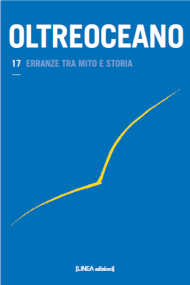De la tierra prometida a la patria dada: El cuerpo en que nací de Guadalupe Nettel
DOI:
https://doi.org/10.53154/Oltreoceano11Keywords:
literatura mexicana contemporánea, Guadalupe Nettel, migración, cuerpoAbstract
El presente estudio analiza los lenguajes mitológicos vinculados al viaje migratorio en El cuerpo en que nací (2011) de Guadalupe Nettel. Se pretende demostrar que la historia se construye sobre un triángulo migratorio en el que se narran un viaje de México a Francia
y otro a Estados Unidos. Además, hay una tercera línea en el dispositivo narrativo, es decir, el descubrimiento del cuerpo propio como verdadera patria de llegada que la protagonista aprende a habitar.
From the promised land to the given homeland: El cuerpo en que nací by Guadalupe Nettel
This study analyzes the mythological languages linked to the migratory journey in El cuerpo en que nací (2011) by Guadalupe Nettel. It is intended to demonstrate that the story is built on a migratory triangle which narrates two trips, one from Mexico to France and another to the United States. Moreover, there is a third line in the narrative device, that is, the discovery of the body itself as the true homeland that the protagonist learns to inhabit.
Dalla terra promessa alla patria data: El cuerpo en que nací di Guadalupe Nettel
Il presente studio analizza i linguaggi mitologici relazionati con il viaggio migratorio nel romanzo El cuerpo en que nací (2011) di Guadalupe Nettel, a partire dalla presenza riscontrata di un triangolo migratorio costituito dalla narrazione di un viaggio dal Messico alla Francia e di un altro anelato verso gli Stati Uniti. Inoltre, è individuabile una terza linea all’interno del dispositivo narrativo, ovvero la scoperta del corpo proprio come vera patria che la protagonista apprende ad abitare.
Downloads
References
Cacciavillani, G. (Ed.) (2003): Spazi di memoria. Venezia: Cafoscarina.
Campbell, J. (1959): El héroe de las mil caras. México: Fondo de Cultura Económica.
De Martino, E. (1973): Il mondo magico. Torino: Bollati Boringhieri.
Eliade, M. (1999): Nacimiento y renacimiento: significado de la iniciación en la cultura humana. Barcelona: Kairos.
García Gual, C. (1981): Mitos, viajes, héroes. Madrid: Taurus.
Kérenyi, K. (1958): Los héroes griegos. Girona: Atalanta.
Kirk, G. S. (2006): El mito. Su significado y funciones en la Antigüedad y otras culturas. Barcelona: Paidós.
Le Bretón, D. (2012): Antropología del cuerpo y modernidad. Buenos Aires: Nueva Visión.
Merleau-Ponty, M. (1994): Fenomenología de la percepción. Barcelona: Península.
Nettel, G. (2008): Pétalos y otras historias incómodas. Barcelona: Anagrama.
Nettel, G. (2011): El cuerpo en que nací. Barcelona: Anagrama.
Nettel, G. (2020): Los divagantes. Orsai, 6, pp. 22-37. Recuperado de https://hernancasciari.com/revistas/revista_orsai_num_6
Ricoeur, P. (2003): La memoria, la historia, el olvido. Madrid: Trotta.
Todorov, T. (1993): Las morales de la historia. Barcelona: Paidós.
Van Gennep, A. (2008): Los ritos de paso. Madrid: Alianza.
Downloads
Published
How to Cite
Issue
Section
License

This work is licensed under a Creative Commons Attribution-NonCommercial-ShareAlike 4.0 International License.
The authors undertake to comply with the following conditions, which are considered accepted at the time of submission of their contributions.
The sending of a text implies that it is unpublished and not submitted to be published elsewhere.
1. If accepted, the author shall confer on the publisher the right to publish and distribute it both in paper form and in the online electronic edition. The published articles will be downloadable and made available in open access.
2. Provided that it correctly indicates that the first publication took place in the journal Oltreoceano. Rivista sulle migrazioni the author has the right to: a) reproduce the article in separate extracts or collected in a volume; b) publish the article on their personal website or teaching site provided that these sites are of a non-commercial nature; c) deposit the article in online archives of a non-commercial nature, linked to the institution they belong to or as part of projects for the non-commercial dissemination and open access of scientific works.
The use of contributions by third parties, for commercial or otherwise unauthorized purposes, is not allowed. The publisher declines all responsibility for the unauthorized use of the material published in the journal.












